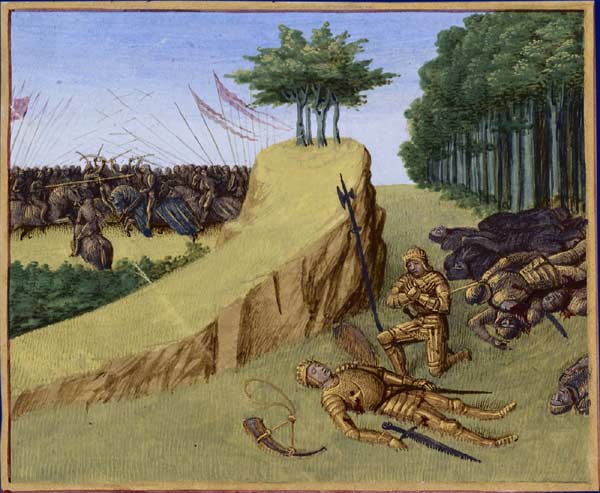Near the end of the fight, when it is clear that the Franks are losing, Roland uses an instrument called an oliphant to call in Charlemagne's army. He does this only when it is too late for the army to change the outcome of the battle:
“They are very close, the king too far away.
You were too proud to sound the Oliphant:
If Charles were with us we would not come to grief.
Look up above us, close to the Gate of Spain.”
The use of the instrument itself is what eventually kills him, through a head injury:You were too proud to sound the Oliphant:
If Charles were with us we would not come to grief.
Look up above us, close to the Gate of Spain.”
"And now Count Roland, in anguish and in pain,
With all his strength sounds the great horn again.
Bright drops of blood are springing from his mouth,
Veins in his forehead are cracking with the strain."
Link
(It is worth noting that he doesn't die immediately but that the injury contributes to his eventual death.)
(It is worth noting that he doesn't die immediately but that the injury contributes to his eventual death.)
What a way to go. But what exactly is an oliphant? According to the story, it is a "great horn." Just how big was the horn? What did it look like? We see a horn in this 1460 rendition of the scene where Charlemagne finds Roland dead:
While there are no pictures of the specific horn used by Roland, there are many examples of an "oliphant" to be found:
The horn is next to the corpse (Link)
Pictured: not Roland's horn (Link)
These horns were almost always decorated with intricate images, often depicting wildlife or mythical creatures. They were expensive and in most cases made from real elephant tusks, hence the name "oliphant" which means "elephant." They were primarily used as musical instruments, but aside from being used to make sound and to accidentally kill heroes, they were used as gifts and passed down as heirlooms (Link).
Roland's use of the oliphant was a small part of the story, but a major one nonetheless. It is interesting to imagine what this instrument would have sounded like out in an open field, blown hard enough to burst blood vessels.
References
Rois, Robert. (2013). The Oliphant and Roland's Sacrificial Death. Retrieved from http://anthropoetics.ucla.edu/ap1802/1802Rois/
Image 1: https://www.wikiart.org/en/jean-fouquet/the-emperor-charlemagne-finds-roland-s-corpse-after-the-battle-of-roncevaux
Image 2: http://www.britishmuseum.org/research/collection_online/collection_object_details.aspx?objectId=60103&partId=1
Lord, Suzanne. (2008). Music in the Middle Ages: A Reference Guide. Retrieved from https://books.google.com/books?id=3cxx3jL1bskC&pg=PA154&lpg=PA154
Image 1: https://www.wikiart.org/en/jean-fouquet/the-emperor-charlemagne-finds-roland-s-corpse-after-the-battle-of-roncevaux
Image 2: http://www.britishmuseum.org/research/collection_online/collection_object_details.aspx?objectId=60103&partId=1
Lord, Suzanne. (2008). Music in the Middle Ages: A Reference Guide. Retrieved from https://books.google.com/books?id=3cxx3jL1bskC&pg=PA154&lpg=PA154





This was such an interesting part of the text! He blew the horn so hard that "he burst his temple" and it continues, "his brains started to ooze from his ears". What an unashamedly explicit image! Great post :).
ReplyDeleteIt was very graphic to read about the strain it put on whomever blew the horn and really emphasized the poetry within the song. Hard to believe these events truly happened to a certain extent.
ReplyDeleteI was curious while reading what kind of horn could hurt someone who played it like that the image you found certainly looks cool!
ReplyDelete